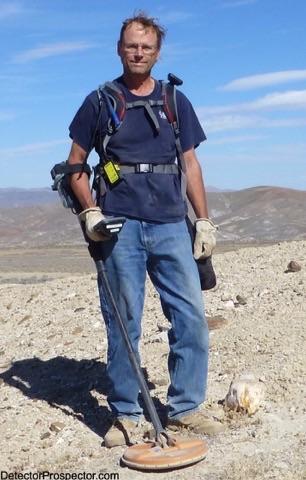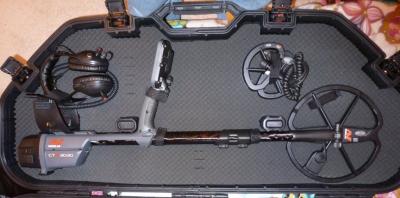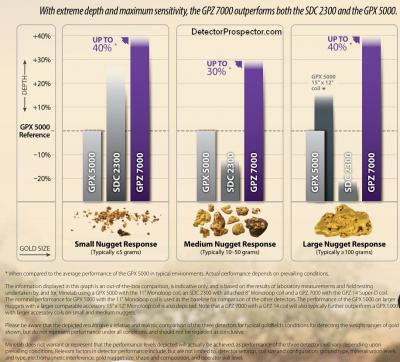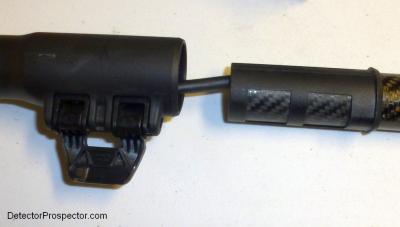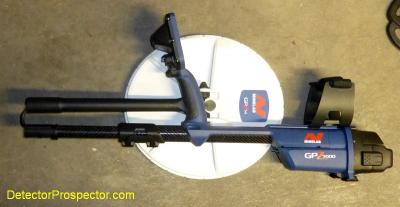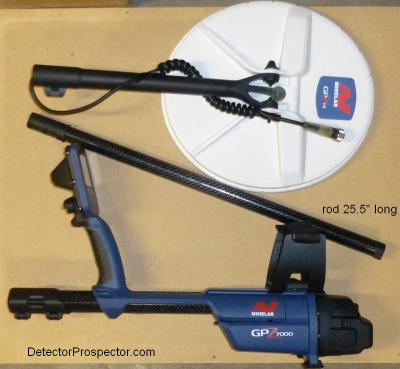-
Posts
19,773 -
Joined
Content Type
Forums
Detector Prospector Home
Detector Database
Downloads
Everything posted by Steve Herschbach
-
There is a very serious case to be made that a SDC 2300 and GPX 5000 together with a range of accessory coils for the GPX represents a viable and perhaps preferable alternative to the GPZ 7000. There is as of yet no single detector solution that solves all situations that a person might encounter.
-
Very good time to get a used GPX dirt cheap. Kind of ironic when the main thing undermining sales of new GPX detectors is used GPX detectors.
-

GPZ 7000 ZVT Technical & Audio Questions
Steve Herschbach replied to AussieMatt's topic in Minelab Metal Detectors
Pretty hard to say rushed to market since this thing probably was conceived before the GPX 5000 came to market. Discrimination seems an option. I always chuckle at the concept that any company should not be trying to make money. Minelab is owned by shareholders and they have a serious legal responsibility to look out for the interests of the shareholders. Any attention paid to customers has to be with that interest in mind. If I was running the show, and if I had a lead in the technology, I would absolutely not lay all my cards on the table at once. No responsible CEO does or he gets fired. I would say you can 100% expect new GPZ models every few years with new abilities and options, and that many of those abilities exist in the lab right this moment for delivery years from now. That is just how business works. In that regard I would not expect Minelab to be any different than any other corporation. If Minelab had serious competition it might be another story. Usually companies are straining to leap frog each other. The only real competition Minelab seems to have when it comes to this technology is Minelab. -
The GPX prices should stabilize now that many people are digesting the fact they will probably be keeping theirs. Or buying a new one since it is now the bang-for-the-buck option. Interesting how yesterday's top price magically became today's mid price. Perceptions are resetting. I am having the opposite feeling about forum discussions however. There is remarkably little discussion of the GPZ on most forums. The only action appears to be here and on the Australia Gold Detecting & Prospecting forum. I am guessing this reflects that for many people the price is just so high there is nothing to talk about. Here it is just flavor of the week. Was ATX, then SDC, now GPZ. When it settles down people will realize they can still buy a Gold Bug for $499 and go find gold.
-

GPZ 7000 ZVT Technical & Audio Questions
Steve Herschbach replied to AussieMatt's topic in Minelab Metal Detectors
Audio in a VLF detector while in discrimination mode can very much be a creation of the engineer. The signal is intercepted, interpreted, and delivered to the operator. The sound that is delivered can be anything the engineer wants, including the words "you have found a dime". When a VLF is in pure threshold based all metal mode you are listening directly to the detector with minimum filtering introduced. You hear nuances of the ground signal itself and other audio details. A PI is normally a true all metal type unit that delivers the signal with minimal processing. The GPX detectors are probably the most processed models. The SDC offers a livelier audio. The GPZ is sort of between the two. Long answer to say yes, you can get a bit of an idea what is going on from the audio. The Minelab PI dual tone response is an artifact produced by the current ground balance setting and the relation of the target to that setting. The thing here is the GPZ really is new. It is a hybrid; it is not pure PI nor pure continuous wave (VLF) but has attributes of both. From http://www.whiteselectronics.com/the-hobby/knowledge-base/field-reports/how-metal-detectors-work "a typical PI search loop contains a single coil of wire which serves as both the transmit and receive coil. The transmitter operates in a manner similar to an automobile ignition system. Each time a pulse of current is switched into the transmit coil it generates a magnetic field. As the current pulse shuts off, the magnetic field around the coil suddenly collapses. When this happens, a voltage spike of a high intensity and opposite polarity appears across the coil. This voltage spike is called a counter electromotive force, or counter emf. In an automobile it is the high voltage that fires the spark plug. The spike is much lower in intensity in a PI metal detector, usually about 100 to 300 volts in peak amplitude. It is very narrow in duration, usually less than 30 millionths of a second. In a PI metal detector it is call the reflected pulse." With PI detectors it is the voltage spike that presents many problems. The coil is "ringing" after the spike and needs to calm down before the detector goes into receive mode to look for targets. This historically has limited PI detector ability to find tiny gold nuggets. The SDC 2300 works by minimizing this delay time, enhancing its ability to find small gold. The GPZ works it's magic by never shutting the current off. Instead, the polarity is reversed by the circuit with no spike occurring and no delay needed other than whatever the engineer desires. Instead of the signal decay being measured from the moment the current shuts down, it now is measured from the moment the polarity reverses. Where Minelab loses me is in explaining how the signal decay in the target can actually decay if the current never shuts off. The target is constantly "illuminated". I assume it has to do with the reversal of the polarity but I am not clear on this point. Minelab is still working in the time domain here and so the detector acts like a PI detector. However, eliminating that spike and working with a continuous current has many benefits. I was told that the ground itself is energized by that spike and the elimination causes the ground to be less resonant with the electronic field that is being produced. Reducing the ground effect is one huge benefit, as is reducing any need to dampen or deal with the transient voltage spike, allowing for easy detection of small gold. At the same time the continuous field that is produced is more consistent in that it does not ebb and flow like a pulse field. Again, this can help with detecting small gold. Oh yeah, ZVT. The reversal of polarity takes place at the instant when the current is at zero voltage. You cannot shut current off instantly but you can turn it on a dime at the instant of zero voltage. It makes for a cool sounding acronym - Minelab loves acronyms - and so ZVT. In a nutshell I think it is the elimination of the transient voltage spike and the issues related to it that is producing benefits here. A layman trying to explain things in layman terms but I think that is the gist of it without mangling it too bad. I am sure brighter minds than mine will have issues with some of what I have said and I truly hope somebody that knows better can chime in and explain it better yet still in terms most people can understand. If nothing else, I do know we will see a paper from Bruce Candy very soon explaining it all, so stay tuned. -
I am not betting against technology. I am betting I will be too old to care!
-
I am doubtful of locating gold directly this way. However, it could work very well indirectly. During huge floods it is not only gold that reconcentrates but 150 years worth of nails, spikes, pipes, and other ferrous junk. The kind of junk a PI loves. I have no doubt locating these junk deposits and dredging them would be a viable concept for a mining operation.
-
Anyone that knows the history of gold rushes knows they are very limited in duration. To clarify, I mean gold rushes as occur on the scale of the individual prospector. A person working more or less on their own with limited means. In a classic gold rush a new discovery is made, and the prospectors "rush" to the area. Typically there are very high amounts of gold found early on as easy pickings are plentiful. Unfortunately the easy pickings are soon gone, and the prospectors wait until a new discovery is made. They once again rush to the new area, and the cycle repeats. Some gold rushes are purely economic. A quiet gold rush occurred during the Great Depression not because new gold locations were found, but because people were desperate to find income of any sort wherever it could be found. The gold rush in the 1980s was a result of skyrocketing gold prices. Another way a gold rush occurs is when new technology takes hold. The development of the light weight portable suction dredge created a small gold rush as prospectors took to the hills with this ability to work underwater in streams and rivers. We are in the latter days of the electronic gold rush. It really took off in the 1980s in Australia with the development of decent VLF detectors capable of finding gold nuggets. The VLF Gold Rush. The easy surface gold depleted, but then a second wave developed with the introduction of the Minelab PI detectors in the 1990s. The Minelab PI Rush has largely run its course. It really has only been kept alive by steadily increasing gold prices as the gold finds themselves dropped off. We can find half as much gold at $1200 as we did at $600 and still pay for beans and fuel. Gold prices have been weakening however, and the technology itself reached a dead end five years ago. I have seen the end coming for some time. It is not just gold prices and the technology but increasing regulation and ever more difficult access issues. The entire Electronic Gold Rush has taken place in my adult lifetime and I am likely to see the day when there are only a few diehards left at it. The good news is in my opinion we are on the eve of what may possibly be the last gasp, the last breath of fresh air. The GPZ 7000 really is a new twist on electronic prospecting that promises to give prospectors what it ultimately takes to fuel any gold rush. Hope. We have to have new hope, a new reason to believe once again we can go out and make worthwhile finds. The GPZ will succeed simply by getting everyone to hit everything one last time, as hard as it can be hit. There is not one bit of ground I have ever detected that I would not give another go one more time, just because I have a GPZ 7000. That means I and others will find gold that until now has gone missing. People will point out that other detectors may well have found some of the gold. That it simply got missed before and now the GPZ found it. They will in many cases be correct, but in the end I think they are missing the point. It is that renewed hope, that renewed faith that really matters, as once again prospectors hit the field in numbers with what they perceive as being the latest and greatest. And when it comes to gold rushes, perception is very much reality. I am just thankful I was born when I was. Sometimes I think I should have been born in the 1800s, but the fact is I enjoy all the things modern life offers me. Instead, I got to participate in the 1980s Gold Rush in all its glory, both as a prospector and as a guy selling the shovels to the prospectors. Now, semi retired and living the dream as a full time prospector I have a chance to participate in what may very well be the last chapter of the electronic gold rush - The GPZ Gold Rush. I have to admit I am very happy to be in the right place and time to get in on the ground floor of one last party! Exciting times my friends. Good luck to each and every one of you now and in the future days ahead.
-

Minelab SDC 2300 vs GPZ 7000
Steve Herschbach replied to Jeff Pierce's topic in Metal Detector Advice & Comparisons
The thing I am always trying to convey is no one detector is best for all people under all circumstances. Life does not work that way. If it did there would be one model of car and we all would drive it. Just because the GPZ 7000 came out all other gold detectors did not become obsolete. I think it is 80% operator and 20% detector and that is probably giving the detector too much credit. As things stand right now the GPZ 7000 has some areas that would make a person consider other detectors: 1. The price 2. The weight 3. The lack of small coil option 4. The lack of large coil option 5. Lack of discrimination Until we get the GPZ 10000 at 3 lbs for $1000 with full discrimination and full range of inexpensive coil options there will be plenty of room for alternatives. -

Will GPZ 7000 Fit In Suitcase?
Steve Herschbach replied to fredmason's topic in Minelab Metal Detectors
The Plano 108110 Bow Case gets mentioned a lot as a good case for the CTX 3030 http://www.treasurenet.com/forums/minelab/335875-storage-travel-case-ctx-3030-a.html I may have to get one for my GPZ. -

Minelab SDC 2300 vs GPZ 7000
Steve Herschbach replied to Jeff Pierce's topic in Metal Detector Advice & Comparisons
Hi Jeff, welcome to the forum! I know people distrust sales brochures but the chart below from the GPZ brochure really says it all. There is a catch however. If you are on relatively shallow ground, and there is a lot of that around, the SDC 2300 can do every bit as well as the GPZ 7000 or better. The extra GPZ depth matters but little in shallow ground. That 8" SDC coil can get around the base of rocks, down in depressions, and between roots where the 14" GPZ coil will not fit. If it was a case of one or the other, cost is no object, I am going with the GPZ 7000. But I can see a person also just using the SDC 2300 exclusively as a hot sniper unit and doing very well with it, especially in rough high Sierra type terrain. Terrain gets discussed rarely but in really rough brushy ground slow and methodical with a smaller coil really has advantages. I will keep my SDC for sure until a smaller coil is available for the GPZ but even then I suspect I will keep it anyway. It is just too handy for grab and go detecting or serious light weight hike in kind of stuff. Once a small coil for the GPZ comes out it will sort itself out. I have to admit at the end of the day I tend to go for power, and if the SDC just goes unused long enough it may get sold off. But it is going to probably take a year for me to sort that out! -

Removing Gold From The Country You Find It In?
Steve Herschbach replied to rumblefish's topic in Detector Prospector Forum
When I visited Australia taking the gold home was no problem unless the total amount was measured in kilograms. A few ounces was no problem. Same with bringing gold through Canada. -

Zero Voltage Transmission (ZVT)
Steve Herschbach replied to jasong's topic in Minelab Metal Detectors
Bad for White's, good for First Texas. I would love to see First Texas introduce something that would rock the prospecting world. Minelab could use some stiff competition. To put it in perspective however Minelab could dust off the old SD2200v2 and release it again and have an entry level PI as good or better than what the competition offers. Instead of others catching up Minelab seems to be consolidating its technological lead. -
The budget process under way includes some proposed changes to the mining law that claim owners or those thinking of owning claims need to be aware of. From BLM Bureau Highlights page 12 http://www.doi.gov/budget/appropriations/2016/highlights/upload/BH007.pdf "The second legislative proposal institutes a leasing pro- cess under the Mineral Leasing Act of 1920 for certain minerals—gold, silver, lead, zinc, copper, uranium, and molybdenum—currently covered by the General Mining Law of 1872. After enactment, mining for these metals on Federal lands will be governed by the new leasing process and subject to annual rental payments and a royalty of not less than five percent of gross proceeds. Half of the receipts will be distributed to the States in which the leases are located and the remaining half will be deposited in the Treasury. Existing mining claims will be exempt from the change to a leasing system. The proposal also increases the annual maintenance fees under the General Mining Law of 1872 and eliminates the fee exemption for miners holding ten or fewer mining claims. These changes will discourage speculators from holding claims that they do not intend to develop. Holders of existing mining claims for these minerals could voluntarily convert their claims to leases. The Office of Natural Resources Revenue will collect, account for, and disburse the hardrock royalty receipts." Note that these are listed under a heading as changes relating to hardrock mining reform. Without seeing the actual proposed legislation it is not clear but it would seem unlikely that this would not end up applying to all claims on federal land, including placer claims. In the future there would be no new claims, only leases, subject to leasing fees and a royalty of not less than 5% of gross receipts. This means you could lose money and still owe a royalty. Furthermore the Small Miners Exemption would be eliminated, and annual fees increased for existing claims. Before everyone goes ballistic keep in mind proposals like these have been floated for decades and so it is not a given it will come to pass. The big boys will certainly fight the leasing and royalty portions. However, they will not care about the Small Miners Exemption. If you do, you may want to dig deeper into the proposals and keep an eye on their progress. This would have a devastating impact on club ownership of claims in particular.
-
Here is where the lower rod clamps to the upper rod. I guess you could cut CTX rod off and use if you had that plastic mating sleeve and end up with a really long rod assembly. Note that the male end protrudes along one side just like the upper portion of the rod, so it can only plug into the lower rod one way.
-

Will GPZ 7000 Fit In Suitcase?
Steve Herschbach replied to fredmason's topic in Minelab Metal Detectors
It fully assembled at 52" is too much the next simplest step is to pull apart where lower rod clamps to upper rod and fold double. This gets you to 32" long. You want to protect cable at bend to prevent kinking or rubbing against edges of rod openings. This is probably the most practical stowed position and so a padded case 32" long would be nice and have room for chargers, etc. -

Break Even Hobbies?
Steve Herschbach replied to Rick K - First Member's topic in Detector Prospector Forum
There is a thread on it at http://www.detectorprospector.com/forum/topic/375-gold-over-5000-per-ounce/ But short answer is always have it for sale and make sure people know it. Then set your price and stay firm. People will say "oh, that is too much!" And my answer is always "well, thanks for looking" or "thanks for the offer." As long as you do not care if you sell it or not you can almost always eventually get your price. There are people who can buy my house with pocket change. When you find them price is no object - they either want it or they do not. The key is be content to keep your gold but be willing to sell it, but only on your terms. Selling under the gun is always a bad idea. -

Will GPZ 7000 Fit In Suitcase?
Steve Herschbach replied to fredmason's topic in Minelab Metal Detectors
Yes, it breaks down into three basic components, the longest being the middle rod section at 25.5" long. It all fit comfortably in my not overly large backpack. However, when fully assembled even when collapsed the GPZ will not fit in normal detector carry bags. It is 51.3" long in the laid flat stowed position fully assembled. -

Zero Voltage Transmission (ZVT)
Steve Herschbach replied to jasong's topic in Minelab Metal Detectors
White's was issued a patent recently on a hybrid VLF/PI design but I am not sure how related they are. Still, good information to be gleaned http://www.detectorprospector.com/forum/topic/118-half-sine-metal-detector-technology-hybrid-induction-balance-pulse-induction-metal-detector/ -
If I could own one and only one detector to prospect for gold and the only choices I had were the ATX and SDC 2300 I would have to go with the ATX personally. It has its issues but at the end of the day it has three coil options. I really like my SDC 2300 but that hard wired 8" coil really limits its viability when it comes to owning one and only one detector. The SDC in the Eureka Gold box with optional coils would be a game changer. As would a 4 lb ATX under $2000.
-

Break Even Hobbies?
Steve Herschbach replied to Rick K - First Member's topic in Detector Prospector Forum
Here is to the hunt! "There's gold, and it's haunting and haunting, It's luring me on as of old. Yet it isn't the gold that I'm wanting, so much as just finding the gold." Robert Service - Spell of the Yukon -

Break Even Hobbies?
Steve Herschbach replied to Rick K - First Member's topic in Detector Prospector Forum
I do have to mention the other perspective that does exist. I get that most people do not live where there is much gold or are not that into it. But for a serious prospector a GPZ does not represent much more than an investment. The only question is how long to hit break even. I do sell my gold regularly, and never sell for less than $2000 per ounce these days. So five ounces to hit the $9999 mark. Maybe another ounce for gas, food, etc. How long to get six ounces? One just never knows. It could take me two years, or it could be the first nugget. But for many prospectors, especially in Australia, going after 6 ounces is not exactly an earth shattering thing. And when it is all said and done the detector will have retained some value on the used market, that can be rolled over into the GPZ 7500 whenever it appears. I will let you know. I just got my shiny new GPZ 7000 and I am not counting gold found with the prototype. Starting today, how long until I hit the six ounce mark? We shall see. -

Break Even Hobbies?
Steve Herschbach replied to Rick K - First Member's topic in Detector Prospector Forum
There is a lot in what you say Rick. On the other hand, I think the rapidity of the price escalation has set people back. Most detectors cost hundreds of dollars. I remember seeing my first thousand dollar detector and thinking that was crazy. It really is only the Minelab PI detectors with their lock on high end performance that is driving the sky high prices. When you finally get your head around $5795 the jump to $9999 does come as a shock. Whatever. No matter where we are in life most of us see things we would like to have but can't afford. Or simply will not spend the money on. Most of my friends have bigger houses, bigger trucks, and bigger RVs than I. There really is more to it than just the detector and no reason a person can't do well with whatever they can afford.

